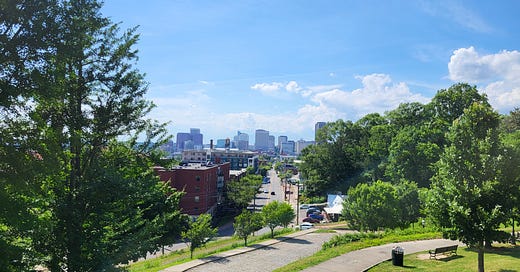4:30pm Wednesday, June 25, 2025
We have reached the crest of the current heatwave in Richmond.
A quick look at the clouds outside shows thunderstorms in Bon Air and Chester, as well as areas northward toward Lake Anna, Culpeper, and the Shenandoah Valley.
Storms can be seen erupting this afternoon in the imagery below, with the easterly winds aloft sending the tops of the clouds westward (right to left across the image).
This is an encouraging sign — to look for a few showers and/or thunderstorms to return to Richmond over the next few days. And because it is so humid, they may produce some especially intense rain.
Even with these little breaks, it will not be cool. We will return to the upper 90s Thursday before edging back to the low-mid 90s for Friday and the weekend.

Getting to 100 degrees is not common in Richmond. It did not happen at all during the 1960s. In fact, over the past century it happens — on average — once a year. And at last check, both Tuesday and Wednesday this week stopped at 99 degrees.
Richmond did reach 100 degrees ten times in 2010, with seven of those days coming in July — when some of our most intense heat waves begin.
Dialing back a bit, the longest consecutive stretch of days of at least 90 degrees came in 1995, with 27 days between July 11 and August 6.
More specifically to June, the most consecutive days of at least 90 degrees within the month is 13, which happened in 1943 and again 2008.
The infamous humidity
Worse, the humidity is back this month. We had gotten spoiled recently, as the three previous Junes have been near or less humid than average. However, this month has swung dramatically back in the other direction. Although there are a few more days to go, this June will likely finish as one of the five most humid since regular measurements of humidity began in 1943.
In the chart below, each bar represents the average June humidity since the 1940s. The bar on the far right is 2025 (through June 24).
Expanding to the entire summer (June through August), 11 of the last 13 summers have been more humid than average, highlighting that a warming climate is also a more humid climate.
Higher humidity also keeps nights from cooling as much. Tuesday’s low temperature of 78 degrees tied the warmest low temperature for the date (set in 2010). It is also the warmest low temperature of any June night on record.
And June is unquestionably getting warmer. Using a 30-year rolling average, June is now about 2 degrees warmer than a century ago, with a monthly temperature now averaging 75.5 degrees.
That trend is also seen during summers as a whole, which have warmed 2.7 degrees since 1970.
So far this month, the average temperature is 76.7 degrees, which already puts us among the 15 warmest Junes on record. Temperatures will be warmer than normal for the rest of the month, meaning we will probably finish in the top 10.
Nonetheless, it is doubtful we get into the record territory from 2010 — the only year that the average June temperature was above 80 degrees (81.1).
More specifically regarding climate change and heat waves, there is not much surprise. As the climate warms, heat waves become more likely, tend to be more intense, and last longer. Days that were once in the middle 90s are now in the upper 90s, and 100-degree days will become more common in the second half of this century.
The video below provides an analogy:
Recognizing heat illness
Summer goes on even as we come down from the peak of this heat.
Remember the symptoms of heat related illness. Even if you are in good physical shape, the body will overheat in high heat and humidity.
And the impacts can sneak up on you in a hurry.
Heat exhaustion is the first sign. Nausea, dizziness, and weakness accompany the sweating, and getting into a cooler environment is critical to prevent the onset of heat stroke. Those symptoms include disorientation or confusion with a potential loss of consciousness. It is a truly life-threatening situation, and it is critical to move the person affected to a cooler area and call 911 for advanced first aid to cool the body down rapidly.
When does it stop?
A more significant break in the heat appears headed into Virginia on Tuesday or Wednesday of next week, meaning afternoons will be in the upper 80s again, and there will also be an easing of humidity.
But in July, the average high temperature is in the upper 80s, so we should all plan to settle in for a hot Richmond summer.










